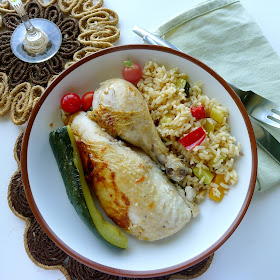 |
| Pan-braised chicken is juicy and tender. |
What a racket! Banging pots and pans, hundreds of demonstrators gathered in Barcelona at the government delegation headquarters. They were protesting government corruption and calling for the resignation of Presidente Mariano Rajoy, who has been accused by the opposition of taking kickbacks from a secret slush fund, in the ‘caso Bárcenas’.
This noisy protest is called a “cacerolada,” or, “pan banging.” A cacerola is a pan, usually metal, with a lid, for cooking foods on top of the stove. It can be a small saucepan, a two-handled pot in which you might boil up potatoes, or a deep sauté pan.
In solidarity with the protestors, I banged some pans in my kitchen. Now, what to cook in this big cacerola? Chicken braised with wine seemed a natural.
 |
| Small chicken just fits in a lidded sauté pan. |
While oven-roasted chicken is so satisfying, I gotta say that a whole braised chicken is ever so tender and juicy. It’s delicious served hot or cold, with or without the winy sauce from the pan. Done in about an hour, it's an easy summer dish that keeps a cool kitchen. (No hotheads here.)
The Barcelona protestors, by the way, may have made a dent in their pans, but not in the ongoing political stew. Presidente Rajoy has yet to answer questions about who knew what when.
 |
| Browned in olive oil, chicken is ready for pan braising. |
Cacerola de Pollo al Vino
Chicken Braised with Wine
Use the tag end of any bottle of wine to cook the chicken--white, rosado (rosé), red, cava (sparkling) or Sherry. If you like, add vegetables--carrots, potatoes, zucchini-- to the pan with the chicken. Chopped parsley or chopped olives can be added at the end as a garnish.
Serves 4.
1 small whole chicken (3 ½ pounds)
Salt and pepper
2 tablespoons olive oil
1 sliced onion
3 cloves garlic
3 plum tomatoes, quartered
Sprig of fresh rosemary
1 bay leaf
2/3 cup white wine
Vegetables, as desired
Tie the chicken legs and wings together so the chicken stays compact. Sprinkle with salt and pepper inside and out. Allow to set at room temperature for 30 minutes.
Heat the oil in a deep sauté pan. Brown the chicken on all sides. Turn it breast side up. Add the sliced onion. Lightly crush the unpeeled garlic cloves and add them to the pan with the tomatoes, rosemary, bay leaf and wine. Cover and simmer the chicken for 40 minutes.
Turn the chicken, breast side down and continue cooking until chicken is tender, about 20 minutes longer.
If chicken is to be served hot, remove it to a cutting board and allow to set for 10 minutes before carving. Pour the pan juices through a strainer, discarding the solids. Skim excess fat off the top of the sauce and serve with the chicken.
If the chicken is to be served cold, allow it to cool completely in the pan. Then remove the chicken to a covered container and refrigerate. Strain the sauce and refrigerate separately.
 |
| Wine-braised chicken with zucchini, ready to serve. |
 |
| Carved and plated, braised chicken is good hot or cold. |


















